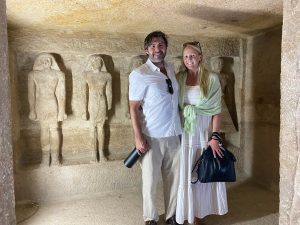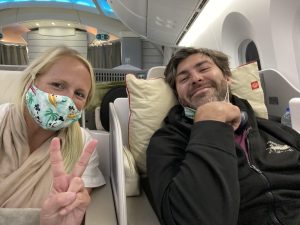Welcome to Cairo
Now traveling on our own, Summer and I left the wilds of Kenya behind and landed in Cairo, Egypt, ready to experience something ancient and new. Thanks to Summer’s work travel hustle, we were able to stay at the Cairo Marriott Hotel & Omar Khayyam Casino, using her saved-up Marriott points to score an amazing room with a balcony view over the Nile – and even the pyramids in the distance.
This hotel was more than just a room – it was an experience. Originally built in 1869 as the Gezira Palace, it was commissioned by Khedive Ismail to host royalty during the opening of the Suez Canal. Today, it still carries the grandeur of its origins: grand staircases, crystal chandeliers, lavish woodwork, and manicured gardens right on Gezira Island in the heart of the Nile. The perfect blend of history and luxury – it felt like we were staying in a slice of Egyptian royalty.
Taking It Easy
After our travel through Uganda and Kenya, we decided to give ourselves a day to just breathe. We explored the palace grounds, lounged by the pool, and started to ease into the Cairo vibe.
At lunch, Summer ordered an espresso martini, which kicked off an entertaining moment: about four staff members tried to figure out what she wanted – they were determined to deliver. After much effort, they returned with a surprisingly delicious custom martini. Cairo may not be a cocktail culture, but the hospitality at this hotel really went above and beyond.
Pyramids, Perfume & Pressure
The next morning, we met our two-person tour team – a driver and a site guide – and headed to Giza. Our day would include the Pyramids, the Sphinx, a perfumery, and a visit to a “papyrus museum” (more on that later).
Driving into the Giza Plateau, the pyramids rise up in the distance, growing impossibly large as you approach. But any mystical illusions vanished quickly once we arrived – the site was jam-packed, and wildly commercialized. Despite all the warnings about cultural norms, we dressed modestly – linen, long sleeves, a shawl for Summer – yet were surrounded by people dressed like it was a music festival. The whole thing had a strong Instagram influencer energy.
There were baksheesh hunters everywhere – people trying to insert themselves into your experience in exchange for money. Inside the pyramid itself, locals literally offered to take pictures of us using our own phones for a tip. It was disheartening. At other historical sites around the world, there’s usually an effort to keep the tourism economy respectful and peripheral. Here, it was center stage.
Things got better when we made our way to the Sphinx, which – to our surprise – was less crowded and more peaceful. The sculpture’s craftsmanship, story, and presence were truly awe-inspiring. The idea that this guardian of the desert greeted travelers for centuries as they approached one of the greatest cities in the ancient world… it hit me in a way the pyramids didn’t.
Unfortunately, the rest of the tour was disappointing. The perfumery was a thinly veiled sales pitch, and the “papyrus museum” turned out to be a glorified art store. When they suggested a third “stop,” we politely declined and asked to head back.

The Egyptian Museum and Cairo Tower
The next day, we struck out on our own. We took a taxi (despite the short distance) to visit the Egyptian Museum – and I’m glad we did, because it was 1000 degrees outside and walking those few miles in the Cairo heat would have been brutal.
The museum itself was incredible. It houses some of the most famous relics in human history – King Tutankhamun’s treasures, royal mummies, massive sarcophagi, and thousands of everyday items preserved from across dynasties. The level of preservation and craftsmanship on display was overwhelming. You could spend days there and still only scratch the surface.
Afterward, we decided to walk across the river to the Cairo Tower, but were stopped on the bridge by yet another aggressive baksheesh hustler. We’d seen false guides before – like in Thailand, where we were told the Grand Palace was “closed for lunch” – but this guy was next-level persistent. He followed us for a solid block, insisting the bridge was closed. I had to firmly tell him to back off before he finally gave up.
The tower itself was gorgeous. It gave us an incredible panoramic view of Cairo, the Nile, and the faint outline of the pyramids in the distance. Standing above it all, the city’s contradictions – chaos and beauty, ancient and modern – became even more apparent.
Culture Shock and Hard Realities
That evening, we decided to walk through the neighborhood near the hotel. Our guidebooks said it was a safe area for tourists, especially on the main streets. Our plan was to find a coffee shop, maybe smoke a hookah, and relax.
We were immediately met with intense stares. Summer, despite being fully covered in a long dress and shawl, stood out as a tall, blonde foreign woman. It quickly became clear that this wasn’t going to be a comfortable night out.
We found a busy-looking café, but it was entirely men – not a single woman seated. As we approached, the stares intensified, and we realized we weren’t welcome. We checked a few more places but got the same vibe. We ultimately gave up and returned to the hotel.
Before heading back to our room, we stopped at the Irish pub attached to the hotel, which is outside the main security gates. It was crowded, smoky… and surprisingly more diverse. For the first time, we saw women seated at tables. But it didn’t take long to realize what was going on – the women were prostitutes. It wasn’t the cultural moment we’d hoped for, but we still appreciated the chance to observe and decompress.
Reflections on Cairo
Despite its challenges, Cairo left an impression. The scale of the pyramids was awe-inspiring, the history at the museum unforgettable, and the Sphinx was truly one of the highlights of the trip.
But we also left with a sense of whiplash. The aggressive tourism industry, the gender dynamics, and the cultural barriers made it feel less accessible than other destinations. That said – we don’t regret going, and it certainly won’t be our last time in the Middle East. We learned a lot.
Next time, we’ll do things differently. We’ve heard that staying in Ras Sudr, where resorts are more accommodating to Westerners, and flying in for day trips is a better option. We also talked about how covering Summer’s hair may have helped – not because we believe in forced modesty, but because when you travel, cultural awareness is everything.
As a student of history, I still believe Cairo is a must-see. But it’s also a city that demands patience, understanding, and careful planning.
Next stop – home. But wow… what a trip.

